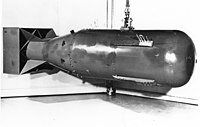
Photo from wikipedia
We sought to study the effects of the ridge furrow (RF) rainwater collecting technique on winter wheat seed filling with limited irrigation under simulated rainfall concentrations and its correlation with… Click to show full abstract
We sought to study the effects of the ridge furrow (RF) rainwater collecting technique on winter wheat seed filling with limited irrigation under simulated rainfall concentrations and its correlation with hormonal changes. The RF system was compared to traditional flat planting (TF) with two limited irrigation levels (150, 75 mm) under three simulated precipitation concentrations (1: 275, 2: 200, 3: 125 mm) during 2015–2017 experimental years. The results indicated that the RF150 treatment with 125 mm rainfall, a significantly improved seed filling rate was observed in the basal and upper seeds. The RF150 treatment with 200 mm precipitation also significantly improved the single seed weight and seed filling rate in the basal and upper seeds. In contrast, the RF system with 275 mm precipitation showed no significant influence on the seed filling rates and seed weight of basal and upper seeds under either limited irrigation level. The RF system at 125 and 200 mm simulated rainfall level exhibited increased (IAA) indole-3-acetic acid and (Z) zeatin + (ZR) zeatin riboside contents. The RF system under 150 mm limited irrigation showed decreased (ABA) abscisic acid and gibberellic acid (GAs) in the basal and upper seeds. The RF system with 275 mm precipitation had no significant influence on the IAA, Z + ZR, ABA and GA contents in the basal and upper seeds under either limited irrigation levels. The IAA, Z + ZR, ABA and GAs in the seeds s were positively correlated with the maximum and mean seed-filling rate and the maximum seed weight. Our results demonstrate that the RF2150 treatment significantly improved the soil water contents and soil respiration rate, thereby regulating the wheat seed filling rate and creating hormonal changes. These fluctuations significantly affected the agronomic properties of winter wheat production in semi-arid regions.
Journal Title: Agricultural Water Management
Year Published: 2018
Link to full text (if available)
Share on Social Media: Sign Up to like & get
recommendations!